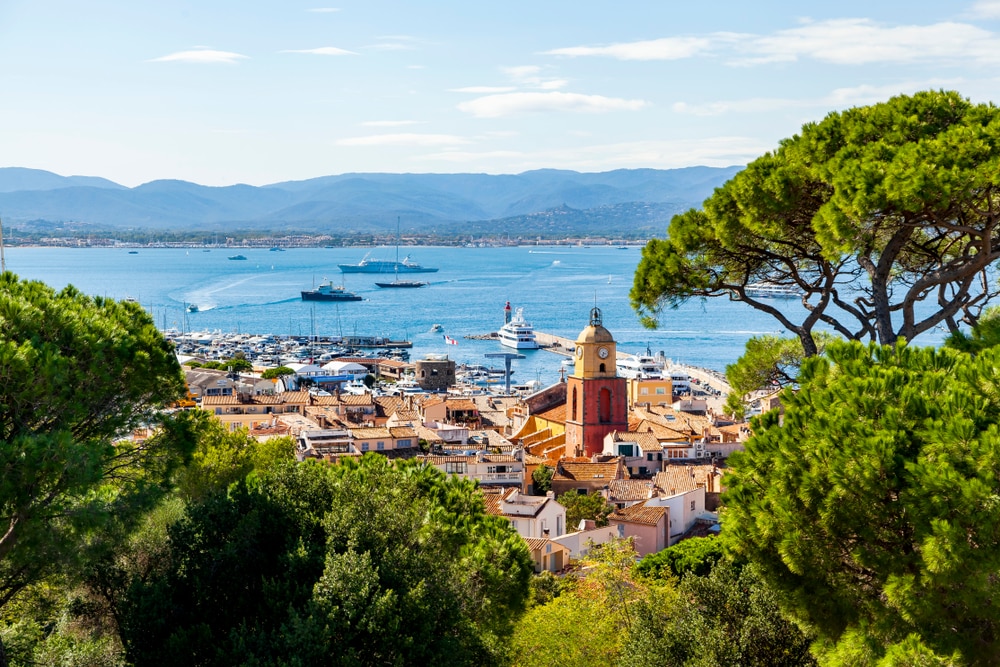When you hear the name Saint Tropez, you automatically think of the glamorous 50s, Curd Jürgens, Gunter Sachs and Brigitte Bardot as well as exclusive beach and nightclubs. Only relatively few “ordinary citizens” treat themselves to a longer vacation in this 4000-inhabitant community on the French Riviera, where the rich and super-rich either own villas or dock with their mega yachts. For a short trip or day trip, however, this expensive pavement with its streets mostly clogged with luxury cars is certainly an unforgettable experience.
Saint Tropez – yesterday and today
The small town of Saint Tropez was originally a fishing village with an agricultural hinterland. The old district of La Ponche with the hotel of the same name, where local men met to celebrate the end of the Second World War, still reminds us of the past. Later, the house developed into an artists’ meeting place and the stars of the 50s and 60s stayed here. As a film set with sun, sea and beach, St. Tropez became world famous and has since attracted members of the jet set and those who would like to become one.
The slapstick films with the choleric gendarme, played by Louis de Funės, also contributed to St. Tropez’s development into one of Europe’s celebrity hotspots after 1970. The police station from these films is now a museum with exhibits and props of the screen successes and one of the sights with the most visitors in St. Tropez.
As early as the end of the 19th century, painters such as Henri Matisse and Pierre Bonnard settled here, who were enthusiastic about the light in St. Tropez and were inspired by this idyll on the Mediterranean. Tourists interested in art should definitely visit the Musée de l ́Annonciade, which is located just a few steps from the port. This former chapel mainly exhibits paintings by artists who lived here at the time and have the landscape around St. Tropez as their motif.
What to do in Saint Tropez?
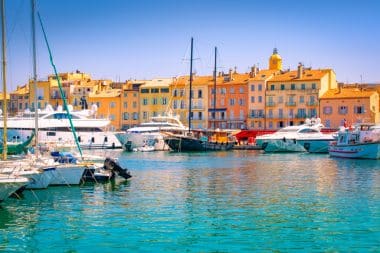
A stroll through the narrow, cobblestone streets is part of a visit to St. Tropez for all tourists. A fish market is held every morning on Place aux Herbes, where locals and holiday home owners stock up on fresh seafood. If you come to St. Tropez, you should definitely be prepared for the fact that the price level in restaurants and shops is tailored to a wealthy audience. The range of boutiques and shops is also not necessarily aimed at shoppers with a tight holiday budget. Nevertheless, a walk through the charming old town with its pastel-coloured houses is worthwhile. The church of Notre-Dame-de L’Assomption de Saint Tropez dates back to the 16th century and has a striking tower that can be seen from afar and is the symbol of the city.
The hexagonal citadel, which was built in 1592 for defensive purposes, towers over the village. Although the complex was destroyed several times over time, it was never taken by the enemies. Today, the former fortress houses a museum on maritime history and the climb is worth it for the fantastic view of the city and the Mediterranean Sea alone. If you are passionate about cemeteries, you should definitely visit the Cimetiėre Marin, which is located just below the citadel and is considered one of the most beautiful in all of France .
The most visited attraction of St. Tropez, however, is probably the large marina, where not only normal sailboats but also the most expensive luxury yachts of the billionaires dock. When the sun is shining, a mild breeze is blowing and the scent of exclusivity wafts over the jetties and jetties, strolling through the harbour with its maritime atmosphere is an absolute pleasure for every visitor. Especially at sunset time, the marina is a meeting place for romantics and photographers.
Attractions in Saint Tropez
- Vieux Port (Old Port): The picturesque Old Port is the heart of Saint Tropez, surrounded by colorful houses and cafes. Here you can admire luxurious yachts and enjoy the hustle and bustle of the harbour.
- La Citadelle de Saint-Tropez: Built in the 16th century, this fortress offers stunning views over Saint Tropez and the sea. Inside is the Maritime Museum, which sheds light on the maritime history of the city.
- Place des Lices: A charming market square where a traditional Provençal market takes place twice a week. Here, visitors can buy local delicacies and handicrafts.
Musée de l’Annonciade
: An art museum housed in a former chapel that displays works by artists associated with Saint Tropez, including Paul Signac, Henri Matisse, and Raoul Dufy.-
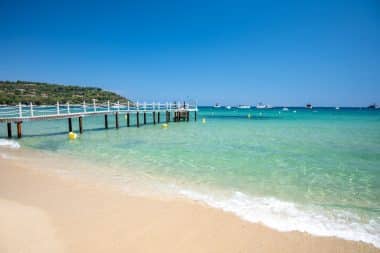
The beach of Pampellone, Image: barmalini / shutterstock Les Plages de Saint-Tropez: The beaches around Saint Tropez are world-famous. Pampelonne beach is arguably the most famous, offering a number of exclusive beach clubs such as Club 55 and Nikki Beach.
- Le Sentier du Littoral: A scenic hiking trail along the coast that offers breathtaking views of the sea and the surrounding countryside. Perfect for a walk in nature.
- Chapelle Sainte-Anne: This 16th-century chapel is located on a hill above the city and offers a beautiful view of Saint Tropez and the bay.
- Markets of Saint Tropez: In addition to the Place des Lices, there are numerous other markets in the city and the surrounding villages where you can find fresh food, flowers and local products.
The beach of Saint Tropez
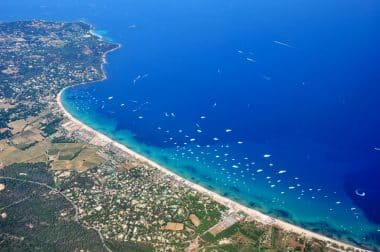
Of course, a not inconsiderable part of the city’s development into a sophisticated summer meeting place for the rich and beautiful from all over the world is due to the beautiful sandy beach Baie de Pampelonne, which stretches over a length of 4.5 km. This is also where you will find what is probably the most famous beach restaurant in the world, “Le Club 55”, which is still only accessible by a narrow path through a small bamboo grove. Although the larger section of the beach actually belongs to the neighboring municipality of Ramatuelle, it is usually referred to as the beach of St. Tropez. The water here is freely accessible to every swimmer and walker and only the rear part of the beach is often privately owned and part of the extensive villa gardens that line the coast. The beautiful Mediterranean landscape here is mainly characterized by pine forests and vineyards.
How to get to St. Tropez
About 15 km southwest of the city there is the small airport, La Mole, which is mainly used by private planes. Most visitors who do not arrive by their own jet land at Nice International Airport, which is located 105 km from Saint Tropez. Those who can afford it can use the helicopter shuttle from there – other guests come to St. Tropez by bus, rental car or taxi.
If you want to go on holiday where high society relaxes, you should bring the necessary change. He is sure to be amazed by the way of life in St. Tropez and the beauty of the area.
History of St Tropez
- Early history and origin of the name: According to legend, Saint Tropez was named after an early Christian martyr, Torpes of Pisa, who lost his life in the 1st century AD. His body is said to have washed up on the coast of today’s Saint Tropez. The city was originally a small fishing village, known as Heraclea.
- Middle Ages: In the Middle Ages, Saint Tropez was part of the Moorish Empire before it was conquered by the Saracens in the 10th century. Over the centuries, the city changed hands several times until it finally became part of France.
- 16th century: In the 16th century, the Citadelle de Saint-Tropez was built to protect the city from attacks by pirates and other invaders. This fortress played an important role in the defense of the coast.
- 19. and early 20th century:In In the 19th century, Saint Tropez remained a relatively unknown fishing village. This changed at the beginning of the 20th century, when artists such as Paul Signac were attracted by the beauty of the place and settled there. Their works attracted more artists and writers, which helped cement Saint Tropez’s reputation as a center of art and culture.
- After the Second World War: In the 1950s and 1960s, Saint Tropez became world-famous due to the rise of the international jet set and films, especially “And the Woman Always Beckons” (1956) with Brigitte Bardot. This marked the beginning of Saint Tropez’s modern fame as a holiday destination for the rich and famous.
The climate of St. Tropez
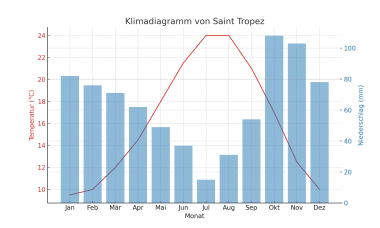
The climate of Saint Tropez is Mediterranean, characterized by mild, humid winters and hot, dry summers. This climate zone is known for its clear, sunny days and is influenced by the Azores high in summer and by the Mediterranean low in winter. Here are some specific characteristics of the climate in Saint Tropez:
- Summer: The summer months (June to August) in Saint Tropez are typically warm to hot with average temperatures that can range from around 21°C to 30°C. The nights are pleasantly warm. There is little rainfall during this time, and the sun shines frequently, making the region a popular destination for beach vacationers.
- Winter: Winters (December to February) are mild with average temperatures rarely falling below 6°C. The temperatures during the day are often between 10°C and 15°C. There may be more precipitation during the winter months, but snowfall is very rare in the region.
- Spring and autumn: These transitional periods are particularly pleasant, with moderate temperatures and fewer tourists. In spring (March to May), temperatures gradually rise, and nature begins to bloom. Autumn (September to November) brings pleasantly warm days and cooler nights, with a gradual increase in precipitation towards the end of the season.
- Precipitation: Most precipitation falls in the months of October to November and also in February and March, while the summer remains mostly dry.


